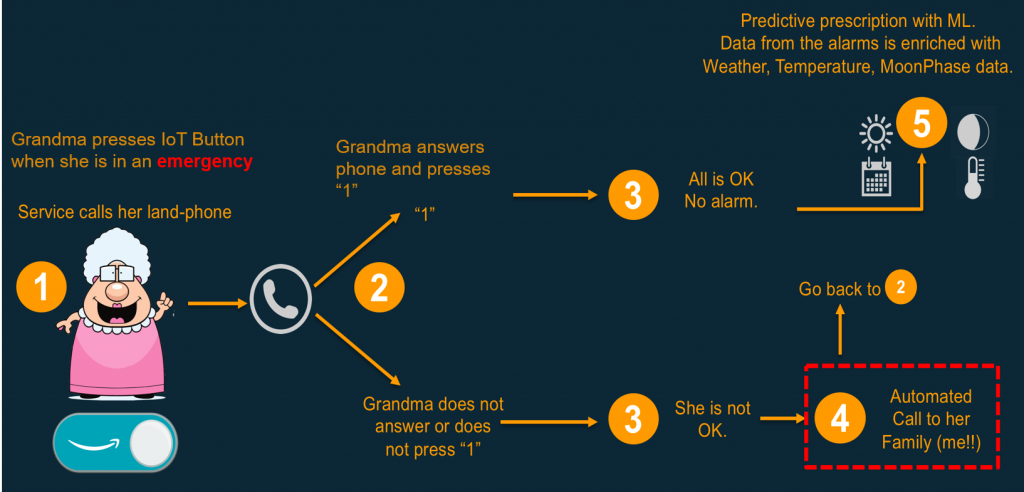AWS Public Sector Blog
Tag: government
Grandma Emergency Button: A simple emergency alert solution with AWS IoT Button
My grandma is 88-years old with reduced mobility. She lives alone, without a caretaker, in a small village. If she falls, then she is in danger. If something goes wrong when she’s in bed, she might need assistance. With an AWS IoT button, she can call for help in a simple way and potentially save her life. Her village provides free Wi-Fi coverage, so I built an emergency alert system using AWS. When she clicks the AWS IoT button, a series of events will take place to get her the assistance she needs. This can help her in difficult situations. It’s a solution that others can create as well. In this blog post, I’ll show you how to get started.
The Path Forward: How State and Local Government Can Overcome Hurdles to Cloud Adoption
The Center for Digital Government surveyed more than 170 state and local government technology professionals to gauge their cloud ambitions and identify sticking points. Based on survey data, government IT leaders perceive four key stumbling blocks around their cloud-adoption efforts.
How to Apply the U.S. Department of Homeland Security’s Continuous Diagnostics and Mitigation Programs on AWS
Continuous Diagnostics and Mitigation (CDM) is an important part of the federal government’s cybersecurity strategy, and it’s getting a boost in visibility since the House passed the Advancing Cybersecurity Diagnostics and Mitigation Act (H.R. 6443). Among other things, this Act directs the U.S. Department of Homeland Security (DHS) to develop and provide the capability to collect, analyze, and visualize government-wide information relating to security data and cybersecurity risks and to make these program capabilities available for use by any federal agency.
November 2018 Top Blog Roundup
It’s almost the end of the 2018 calendar year. Still, no signs of holiday fatigue for the public sector blog. Here are the biggest takeaways from November.
The Public Sector Guide to re:Invent 2018
The countdown is on until re:Invent 2018! This guide is designed to help public sector attendees plan their experience and identify breakout sessions and events of interest. It is intended to complement the re:Invent app, which will help attendees navigate the conference onsite.
5 Ways the Cloud Can Drive Economic Development
Government agencies often look to promote new technology for cost-savings and efficiency – but it doesn’t stop there. The second and third-tier effects of technology can be long-lasting for citizens, businesses, and economies. Our recent whitepaper, 5 Ways the Cloud Can Drive Economic Development, outlines the internal transformation most public institutions experience as a first benefit of cloud adoption. In other words, the cloud drives greater accessibility of data, information sharing, increased productivity, and smarter resource allocation inside the organization.
How Serverless Is Solving Congress’ Full Voicemail Box Problem
Hearing “this voicemail box is full” on the other end of the phone line when trying to reach your member of Congress should not stop constituent voices from being heard. The U.S Congress has been facing this problem for a long time now, causing not only a challenge in community engagement, but also Congressional staff endless headaches. What if the solution was the use of a new serverless application? Article One is doing just that.
October 2018 Top Blog Roundup
With October already in the rear-view mirror, take a look at the month’s highlights from the public sector blog.
Yes, Technology Can Build More Inclusive Societies
The Amazon Web Services (AWS) Institute today released a briefing paper that illustrates how cities are using technology to enhance access to services and quality of life for their residents. As cities become home to the majority of the world’s population, leaders must ensure that urban infrastructure and services can accommodate growth, and that no one is left behind. Increasingly, they are turning to cloud technology for solutions to the challenges they are facing – from problems like traffic, parking, and waste management to public health crises and natural disasters.
Visualizing Diplomacy, Development, and the Environment: An ImpactHack Recap
The United States Diplomacy Center and World Resources Institute hosted ImpactHack, a data visualization hackathon in Washington, D.C. Sixteen teams competed to demonstrate diplomacy’s impact, from state economies to global issues, using their coding and design skills. Amazon Web Services (AWS) sponsored the event, donating the time of several solutions architects, technology, credits, and expertise in managing the hackathon. Over the course of over a single Saturday, these teams developed their submissions. Projects from the hackathon will be used to develop Diplomacy Center exhibit prototypes. Congrats to the three winners!









